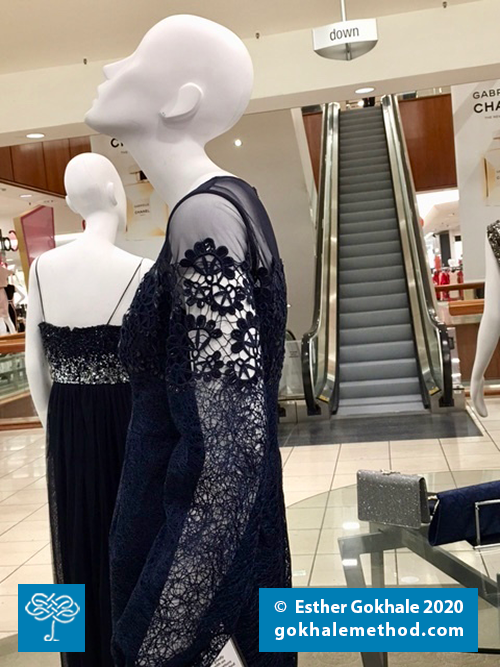How (and Why) to Keep Your Neck Tall
Why is neck length so important? When I have taught in corporate settings, neck pain seems to be an even more common problem than back pain. It doesn’t help that most ergonomic furniture is not only unhelpful, but even counterproductive (the Herman Miller Aeron chair won the “cool” race in corporate America — and it’s my least favorite of all). Posturenomics®, a term I coined, reflects the philosophy that it's not furniture alone, but also knowledge, which together create the conditions for healthy posture.
We’re also surrounded by people who model poor (usually slumpy) posture with forward head — and whether we know it or not, it’s in our DNA to mimic what’s around. And last, but not least, our lay and medical experts have adopted a particularly unhelpful (and in fact, counterproductive) set of posture guidelines (including “chin up,” “chest out,” “stand up straight,” do crunches, tuck your pelvis — all of which harm the neck among other parts of the body).

I photographed this mannequin at the Stanford Shopping Mall years ago. "Her" neck curvature is intense and unhealthy.
Observe this mannequin from the Stanford Shopping Mall in Palo Alto, CA. She cranes her neck to look up. The base of the skull where it meets the neck is fine as a joint to rotate on, but the amount of curvature in her neck here is intense and unhealthy. I like to think of the neck as beginning in the thoracic spine (upper back). T5 is usually at the apex of the thoracic curve. Her thoracic curve is excessive. The origin of this problem is actually lower in the back and pelvis. Her pelvis is tucked, causing excessive sway in the lumbar spine, which gets reflected higher up as excessive curve in the thoracic spine, Then, in order to look ahead of her, instead of down toward the ground, she cranes her neck. If you pattern yourself on mannequins like this, you’ll soon end up bent out of shape.

This renowned arm surgeon working in the OR displays intense neck curvature as well. Unfortunately, many surgeons develop spinal problems.
Observe this surgeon’s cervical (neck) curvature. This posture will not serve to maintain healthy cervical discs and nerves. Surgeons are remarkably able to step up to work incredibly long hours, and sacrifice comfort for the benefit of their patients, but at some point the effects of bad working posture catch up with even the most determined of us. Paresthesias in your hands are not symptoms anyone can will their way past. Surgeons have trust in their craft, and seem to readily subject themselves to surgery (I saw a surprising number of neck scars in my 2-week stint as an observer in the OR at Stanford University hospital). But if surgery is not accompanied by measures that get to the root of the problem, the problem comes back — like it did with my own failed back surgery. The plight of many surgeons is to be forced into early retirement due to injury. They have usually earned enough to have a financially comfortable retirement, but their older years are often compromised by pain and disability. Most of this, based on my experience, is preventable — and such a poor reward for enormous effort and societal contribution.

As is true of surgeons, forward heads and craned necks among dentists often lead to problems over time. Image courtesy H Shaw on Unsplash.
Dentists also receive no training on sustainable, healthy ways to bend over their patients and twist to examine their teeth. A full third of dentists retire early due to disability.

This Yao woman’s head and neck posture are exemplary. Not only does she have a regal and dignified bearing, but her healthy posture also protects her neck and spinal health.
Decades ago, I had the chance to hike to remote locations in the highlands of Thailand. I was fortunate to have encountered this woman and child when I did: more recently, this area has become more heavily trafficked by trekkers and finding a spot where the local people welcome a non-commercial interaction with foreigners is more challenging. But in those days, it was possible. I’m actually the proud owner of a Yao jacket. It has a wool ruff sewn onto a hemp shell, a fabric so durable that only after 30 years is it starting to fray. This woman’s elegant, lengthened neck is something we can all learn to approach.
How to get to a lengthened neck: a few techniques
- Gather in your hands a handful of hair at the base of your skull on each side and gently and smoothly tug upward and backward. Try to pull symmetrically. if you’re able to move your arm back enough to grab one tuft of hair and pull back and up, go for it, but this does require some mobility in the shoulder joint.
- You can also pull on your head itself. Be careful that you’re not pushing or pulling your face in the opposite direction from the front. Your hands should be on your ears or behind them, gently guiding your head up and back.
- My favorite way uses the tips of your three central fingers on each hand (index, middle, ring) on the occiput to gently push the base of the skull back and up.
- You can also imagine that you have a helium balloon inside your head. Survey the area, discover and release tensions, and let your head waft up.
The key ingredient in all of these techniques is to first relax your neck. If you tense your neck, your hands are going to be challenged to help with lengthening. You want to yield to the push/pull of your hands.
There’s more to learn, but if you begin with the above steps, you’ll be well on your way to repairing whatever damage has happened and preventing future damage. Your neck will then be able to live a long and happy life!

Comments
And that picture you took in
And that picture you took in Thailand is so beautiful.
The people were so beautiful,
The people were so beautiful, I don't think a bad picture is possible!
To try to find better fitting
To try to find better fitting glasses, try the online optical shops. They often have more styles than the ones attached to the eye doctors, and they are MUCH less expensive. The downside is that there's no one to help you fit them, so you may have to experiment a bit to find the right pair. But when you're paying $40 instead of $400 (for my progressive lenses in the least expensive frames at Zenni), you can afford a mistake or two.
Thank you for this helpful
Thank you for this helpful post. Could you comment on chin placement and whether it can be included as a cue for achieving correct posture? That is, when the neck and head are properly aligned should the chin be parallel to the ground? Thanks in advance for any clarification you can offer.
Add New Comment
Login to add commment
Login